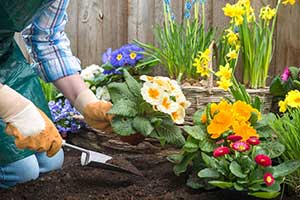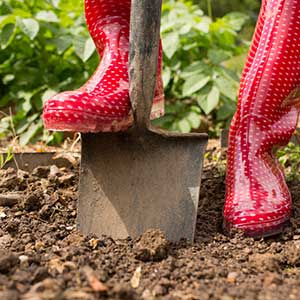The importance of dirt can often be overlooked, but it’s actually an extremely valuable substance that can be used in many things. While the use of dirt can be extremely versatile, it’s important to remember that you have to tailor what kind of dirt you’re using to your particular project. Choosing the wrong dirt can result in costly setbacks to your project and may even require you to start from scratch all over again.
 The two big types of dirt that most people choose for their projects are fill dirt and topsoil. Both have very different compositions and therefore have very different uses. Topsoil is essential for gardening or farming because this type of nutrient-rich dirt helps plants thrive. However, if fill dirt is used for a farming project, plants would have a very difficult time growing because fill dirt lacks the necessary nutrients.
The two big types of dirt that most people choose for their projects are fill dirt and topsoil. Both have very different compositions and therefore have very different uses. Topsoil is essential for gardening or farming because this type of nutrient-rich dirt helps plants thrive. However, if fill dirt is used for a farming project, plants would have a very difficult time growing because fill dirt lacks the necessary nutrients.
Fill dirt is primarily used for construction purposes such as building foundations for home, roads, and buildings. If topsoil is used for these foundations, the project is off to a rough start because topsoil contains organic matter that breaks down over time. This will result in the volume of the topsoil changing, which could then potentially cause any foundations on top to shift.
For landscaping projects in particular, both types of dirt are often needed to achieve the landscape that you desire. If you are unsure on how much fill dirt you may need for your project, consider reading How Much Fill Dirt Do I Need For My Project?
Fill Dirt vs. Topsoil
Fill dirt is composed of broken down rocks, clay, and sand. This means the dirt can be tightly compacted so it won’t shift or move over time, which also means that anything you put on top of it won’t be compromised by the dirt shifting below it. Fill dirt get its name because it’s used for filling holes and and creating foundations for houses or low points in the ground.
 Fill dirt is taken from the ground and is found approximately six inches below the top layer, of nutrient-rich topsoil. The reason topsoil isn’t suitable for foundational purposes is because it contains organic matter. This organic matter is what makes topsoil so great for farming or gardening. However, the organic matter also makes for terrible foundations because it begins to break down over time which will cause the dirt to shift and move around. You don’t want the dirt under your house or driveway shifting, as that could result in severe damage to these structures.
Fill dirt is taken from the ground and is found approximately six inches below the top layer, of nutrient-rich topsoil. The reason topsoil isn’t suitable for foundational purposes is because it contains organic matter. This organic matter is what makes topsoil so great for farming or gardening. However, the organic matter also makes for terrible foundations because it begins to break down over time which will cause the dirt to shift and move around. You don’t want the dirt under your house or driveway shifting, as that could result in severe damage to these structures.
While the idea of fill dirt may bring to mind the ease of just simply digging it up from your backyard and getting to work immediately, it actually isn’t that simple to obtain. The correct, optimum fill dirt has to go through some processing first in order to work as well as it does. It has to be checked for any large chunks of debris that could be hidden inside of it. It also has to be tested and cleaned to ensure that it does not contain any chemicals, toxins, or other manufactured byproducts. Because these processes are necessary, fill dirt has to meet certain local regulations to be used. So, when you’re searching for fill dirt for your project, make sure to find a local certified fill dirt company.
Uses Of Fill Dirt
Fill dirt serves many purposes and functions, here are a few examples:
Changing The Landscape
Sometimes your property can have dips and low points that you would rather not have to deal with in your yard. You may want them filled in for aesthetic purposes, or it may be for more practical purposes such as filling in low points to prevent flooding after rain or snow. You may also find these low points to cause unwanted challenges when mowing your lawn. The solution is to fill the low point with fill dirt, which will quickly even out your land. On the other hand, you may find that your landscape is too boring and flat. Fill dirt can be used to build up some areas to create better dimensions with hilly areas or multi-level terraces.
Construction Projects
The most important part of any construction project is a strong, firm foundation. Fill dirt is so valuable for this because its composition of clay, sand, and rock, won’t move or shift over time. This means your project is guaranteed to have a strong foundation that lasts. Fill dirt is great for creating the foundation of houses, driveways, and roads.
Septic Tanks
Fill dirt can also be used to pack around septic tanks to ensure that the tank stays in place. If the dirt around your septic tanks contains organic matter and begins to break down over time, your septic tank could begin to move and that could cause a nightmare of a problem for you to address.
Alternative Types Of Dirt
If you’re doing a large scale landscaping project, you may find you require dirt for more purposes than those mentioned above. This is where topsoil comes in. Fill dirt is mostly the same, and slight changes in its composition (as long as its certified) don’t really significantly matter. But, when it comes to topsoil there are actually many varieties, and you should choose which soil is right for you based on what you plan to use it for. There are seven different types of soil which include clay soil, silty soil, loamy soil, sandy soil, peaty soil, saline soil, and chalky soil. Each of these soils has a different compositional makeup which makes it better for growing certain plants or flowers, and certain soils perform better in some climates than others.
For your landscaping project, make sure you’re being extremely detail oriented and picking out the right kind of dirt for each part of your project. The two types of dirt can even be used together in some cases. Many people like using fill dirt to fill a low point, and then laying down topsoil over it to create a garden or allow for other things to grow. For more information about fill dirt, reach out to your local fill dirt company for pricing and availability.








































